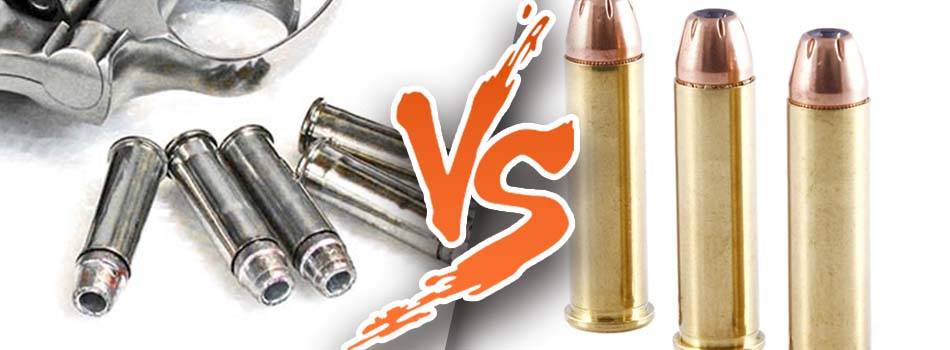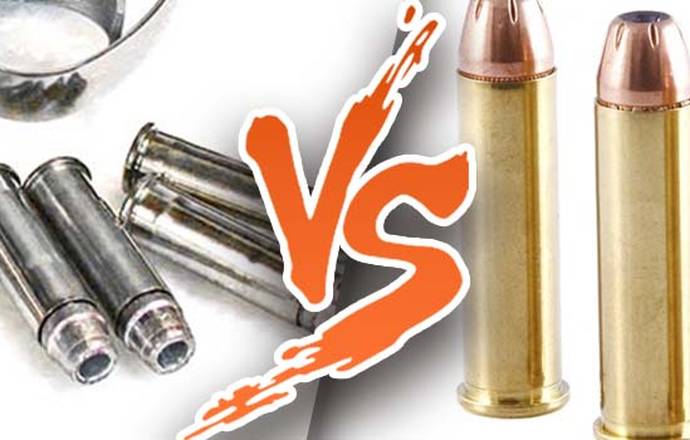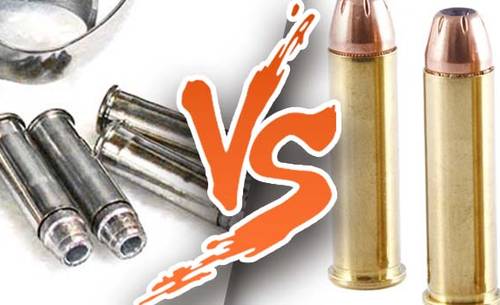


For avid enthusiasts, this is a tough one for many of us to decide—the two famous options of a .38 special vs .357 Magnum.
Choosing the right cartridge for your needs is one of the fundamental foundations of being a good shootist. Making your decision here means breaking down the history, performance, and preference of two well-established and widely available options.
YOU CAN’T GO WRONG—BUT WHAT’S RIGHT FOR YOU?
Both cartridges have served law enforcement, self-defense, and recreational shooters with distinction over the decades.
- The .38 Special, developed at the turn of the 20th century, quickly became a standard for police forces and civilians alike, prized for its reliability and manageable recoil.
- The .357 Magnum, introduced in the 1930s, sought to address the demand for a more powerful round, offering greater velocity and stopping power.
As the tech advanced, both rounds have seen various iterations, expanding their roles in the shooter's arsenal.
Particularly in snub-nose revolvers—a popular choice for concealed carry—the effectiveness of each caliber is a subject of much debate, with advocates on both sides citing performance metrics, practical usability, and personal experiences to support their preference.
.38 SPECIAL VS .357 MAGNUM: HISTORY AND DEVELOPMENT
.38 SPECIAL
The .38 Special cartridge was introduced in 1898, making it one of the longest-serving calibers in the history of personal and law enforcement weaponry. Its early adoption by the U.S. Army and numerous police departments across the country cemented its reputation as a dependable round.
Known for its moderate recoil, the .38 Special allowed for accurate follow-up shots, an essential feature for law enforcement officers. Over the years, advancements in ammunition technology have significantly improved the .38 Special's performance.
Modern +P loads, for example, offer enhanced velocity and stopping power, making the .38 Special a more versatile round that exceeds its original design parameters, thereby maintaining its relevance as a self-defense option.
.357 MAGNUM
In response to calls for a more potent revolver cartridge, the .357 Magnum was developed in the 1930s by Smith & Wesson and Winchester—designed to achieve higher velocities, greater range, and superior stopping power compared to the .38 Special.
The .357 Magnum quickly earned a reputation for its remarkable ballistic performance, becoming a favorite among law enforcement, hunters, and self-defense practitioners.
Its ability to effectively take down larger game, as well as provide a decisive advantage in defensive situations, were big factors for its widespread popularity.
Furthermore, because these two cartridges are the same diameter, you have the versatility of being able to fire the less powerful .38 Special rounds for practice or reduced recoil in your .357 Magnum—a flexible option for a wide range of shooters.
.38 SPECIAL VS .357 MAGNUM: CHARACTERISTICS AND BALLISTICS
The ballistic divergence between the .38 Special and the .357 Magnum is going to be pretty apparent the first time you do some hands-on experience.
- The .357 Magnum, with its longer case, allows for more gunpowder, propelling bullets at higher velocities than its .38 Special counterpart
- A .357 Magnum can achieve typical velocities up to 1,400 feet per second (fps) with a 125-grain bullet
- The .38 Special will reach 900 fps with similar bullet weights
This increase in velocity significantly enhances the Magnum's energy, delivering a more potent impact.
Terminal ballistics—the effect of the bullet upon impact—also diverge significantly. The .357's higher velocity results in greater penetration and, when using expanding bullets, more substantial expansion.
PRACTICAL IMPLICATIONS OF BALLISTIC DIFFERENCES
In defensive shooting scenarios, the .357 Magnum's superior penetration and energy can translate to more effective stopping power. However, this increased power comes with a trade-off in significantly more recoil, which can affect shooter accuracy, especially in rapid-fire situations or for those with less hand strength.
Conversely, the .38 Special's moderate recoil makes it easier to control, facilitating quicker, more accurate follow-up shots.
.38 SPECIAL VS .357 MAGNUM: PRACTICAL APPLICATIONS
Historically, law enforcement agencies widely adopted the .38 Special for its reliability and manageable recoil, making it a staple in police revolvers for decades. However, confrontations requiring superior stopping power prompted a shift towards the .357 Magnum.
This transition was influenced by notable incidents where the .38 Special's stopping power was deemed insufficient. The .357 Magnum offered a compelling alternative, providing officers with a cartridge capable of neutralizing threats more effectively without the need to transition to semiautomatic platforms.
CIVILIAN PRACTICAL USES
For civilians, the choice between these calibers for self-defense often hinges on a balance between power and controllability. The .357 Magnum’s excellent stopping power in a revolver format makes it an excellent choice for home defense or open carry, where concealment is less of a concern.
However, its recoil can be daunting for some shooters, especially in the compact, snub-nose revolvers popular for concealed carry.
THE .38 IS A CONCEALED CARRY STAR
Here, the .38 Special shines, offering a more controllable option that still provides adequate defensive capabilities.
The suitability of each caliber for concealed carry in snub-nose revolvers further influences civilian preference, with many opting for the .38 Special for its ease of use and the .357 Magnum for its ballistic superiority, depending on individual comfort and proficiency levels.
.38 SPECIAL VS .357 MAGNUM: HANDLING AND RECOIL
The handling and recoil of the .38 Special and .357 Magnum have significant implications for shooter comfort, especially when you’re talking small-frame revolvers.
There’s no denying that the .38 Special offers a level of controllability that appeals to a broad spectrum of shooters. This manageability facilitates longer practice sessions, quicker follow-up shots, and, ultimately, higher accuracy, especially for those with less experience or physical strength.
In contrast, the .357 Magnum's sharper recoil can be challenging to master in lightweight, compact revolvers. This heightened recoil can impact shooter accuracy and confidence as managing the gun's movement becomes more demanding.
Training and proficiency are undoubtedly the keys here. Shooters may find that while the .357 Magnum offers superior stopping power, achieving proficiency with this caliber requires dedication to mastering recoil management.
Conversely, the more forgiving nature of the .38 Special allows for a gentler learning curve, making it an excellent choice for new shooters or those seeking a balance between power and ease of use.
.38 SPECIAL VS .357 MAGNUM: PREFERENCES AND DEVELOPMENTS
Modern ammunition developments have notably shifted the performance landscape of the .38 Special and .357 Magnum, blurring the lines between them.
- Advances in bullet design and propellant formulations have enhanced the .38 Special's effectiveness, offering loads with improved penetration and expansion characteristics that narrow the gap with the .357 Magnum.
- Simultaneously, innovations in .357 Magnum ammunition have sought to mitigate its formidable recoil, making it more manageable for a wider array of shooters.
Personal preference, intended use, and physical capabilities play pivotal roles in the choice between these iconic calibers.
- For home defense or situations where concealability is less critical, the .357 Magnum's unmatched stopping power may be desirable.
- Conversely, for concealed carry or those with sensitivity to recoil, the .38 Special's blend of effectiveness and controllability makes it an appealing option.
Ultimately, the decision hinges on matching the caliber to the shooter's needs, ensuring that the chosen round complements their skills, comfort level, and defensive requirements.
.38 SPECIAL VS .357 MAGNUM: MAKING YOUR CHOICE
Choosing between the .38 Special and .357 Magnum is a decision that intertwines practicality with personal preference—but it’s going to boil down to:
- Your understanding of each caliber's capabilities
- How they align with your specific needs, whether for self-defense, law enforcement, or recreational shooting
The .38 Special offers ease of handling and a softer recoil, making it an excellent choice for new shooters or those looking for a reliable and manageable self-defense option. On the other hand, the .357 Magnum delivers superior stopping power and ballistic performance, suited for those willing to train to master its recoil for the added benefits it brings.
Both calibers have their place in the shooter's arsenal, and modern ammunition developments have only broadened their applicability. Advances in bullet design and propellant efficiency mean that choosing one over the other does not necessitate a compromise on performance or safety.
MATCH YOUR CHOICE WITH THE RIGHT HOLSTER
Every revolver needs its proper holster match if you’re going to be able to use your firearm effectively. The knowledge that your concealed carry option is ready and available to you when you need it is half the battle. It’s a battle you’ll hopefully never have to fight, but what if you do?
Check out our selection of top-tier leather, nylon, or Kydex holsters in a wide variety of carry options. You may have the right firearm and the best matching ammunition for it, but unless your holster is up to the job, you’re nowhere.
